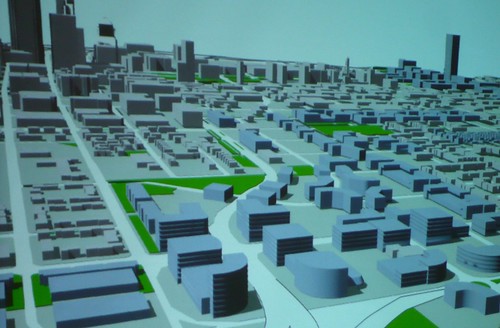by Michael R. Allen
Now that McEagle Properties has started to reveal its plan for north St. Louis and downtown, let’s review the Distressed Areas Land Assemblage Tax Credit Act. Last night at a meeting, Bill Laskowsky from McEagle and planner Mark Johnson from Civitas revealed that McEagle hopes to submit a financial proposal to the city of St. Louis’ Land Clearance for Redevelopment Authority by May 26. That proposal will accompany a request for redevelopment rights and tax increment financing. Various government entities will consider the proposal and make recommendations to the Board of Aldermen.
According to Laskowsky and Johnson, a redevelopment ordinance ideally would be in place by the end of the year so that an application for the Distressed Areas Land Assemblage Tax Credit (DALATC) can be made. The DALATC will allow McEagle reimbursement for 50% of land acquisition costs and 100% of maintenance
While the redevelopment agreement with the city will have its own rules, the DALATC brings its own rules.
Here are a few key provisions to keep in mind:
The DALATC will reimburse McEagle for 100% of demolition costs.
Under DALTAC, “acquisition costs” are defined as the purchase price for the eligible parcel, costs of environmental assessments, closing costs, real estate brokerage fees, reasonable demolition costs of vacant structures, and reasonable maintenance costs incurred to maintain an acquired eligible parcel for a period of five years after the acquisition of such eligible parcel. Acquisition costs shall not include costs for title insurance and survey, attorney’s fees, relocation costs, fines, or bills from a municipality.
The DALATC will reimburse McEagle for half of the cost of mowing lawns and boarding up windows.
“Maintenance costs” are defined in DALATC as the costs of boarding up and securing vacant structures, costs of removing trash, and costs of cutting grass and weeds.
The DALATC is authorized under Chapter 99 of Missouri law.
Under Chapter 99, a redeveloper must follow a certain process to have an area declared blighted by municipal authority; that process is detailed online here. Eminent domain power will reside with the city’s Land Clearance for Redevelopment Authority, not McEagle.
Less than five percent of the acreage within the boundaries of the eligible project area shall consist of owner-occupied residences which the applicant has identified for acquisition under the urban renewal plan or the redevelopment plan.
Let’s make it clear: eminent domain can be used by McEagle in this project. There just happens to be a reasonable limit to its use, and parcels acquired by eminent domain can’t get the DALATC.
No city-owned property is eligible for the DALATC.
McEagle won’t be able to get DALATC for purchase of the hundreds of city-owned parcels it requires for this project. Does that mean that the city will convey the land for a token amount to help the deal move along? Or will the cash-strapped city hold McEagle to the same standards as anyone else who seeks to purchase city-owned land, and charge the typical “full price” for each parcel?
No more than seventy-five percent of the urban renewal area identified in the urban renewal plan or the redevelopment area identified in the redevelopment plan may be redeveloped by the applicant. The remainder of the urban renewal area or the redevelopment area shall be redeveloped by co-redevelopers or redevelopers to whom the applicant has assigned its redevelopment rights and obligations under the urban renewal plan or the redevelopment plan.
McEagle will be working with co-developers. Who are these partners? What area non-profit development organizations are likely to get on board?
The redevelopment agreement shall include a time line for redevelopment of the eligible project area.
The DALATC requires a redevelopment time line be submitted to the city. What is unclear is whether that time line is binding, and what enforcement mechanisms the city or state can implement to ensure completion of the project.
The DALATC sunsets in 2013.
Any attempt to receive all $95 million has to start soon to beat the sunset.

